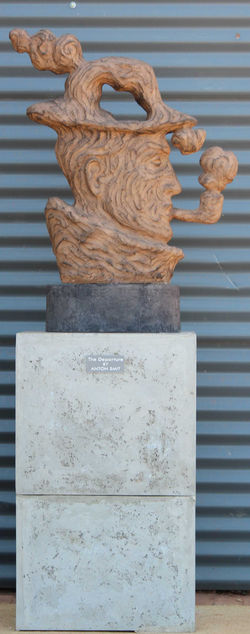 |  |  |
|---|---|---|
 |  |  |
 |  |  |
 |  |  |
 |  |  |
 |  |  |
 |  |  |
 |  |  |
 |  |  |
Curatorial statement for the exhibition, The city: A form of life
As it often happens in the field of the arts, the most progressive challenges to the status quo just appear, seemingly without history or upheaval. Yet, when it happens, very real and conceptual alignments with actual history can be drawn. Pre-1994 there is comparatively little evidence of resistance art of serious mention produced in the greater Pretoria area, which is maybe telling in terms of the enormous repressive impact of apartheid. But nowadays Pretoria has become a retro place where the creative and cultural wealth of the capital city is flourishing in new and alternative ways, often in conversation with an “inherited”, stigmatised and traumatised identity. The decision of having an “uncurated” biennale is part of this conversation, which could be read as a stand against marginalisation and railroading. As a series of “pop-up” events - a no-man’s space or event belonging to no-one and everyone - the Cool Capital Biennale presents a picture of Pretoria now, but could maybe also be viewed as a continuation of artists’ long history of anti-establishment actions, driven by various groups and individuals in vanguard modernity.
Global societies today show patterns of high levels of migration with people physically shuffling and shoving about on the road, the air, the land, the water, and of course, virtually travelling the world on the media highways. Their very lives often become “pop-up” events where neighbours live in anonymity next to each other, and the surname of the person of the other culture is never known. In and after postmodernism and its associated strategies of inclusivity, unbounding, unpacking of buried truths, and demarginalisation, the social media have been exploding, making every facet of personal and public life visible and available to scrutiny. Such radical changes in the structures and patterns in social and cultural behaviour have brought about new awareness of the self – the selfie, the individual – within the midst of the chaos of change, transitivity, commonality and shared space. Questions about the self and its position in society and history, also in conjunction with multicultural alliances, are being configured and refigured. The likes, dislikes and the happiness of the self have become important values in the new cultural systems that show high levels of employment change and entrepreneurial activities.
In addition, since the onset of modernism during the middle of the nineteenth century, authorial structures and voices have increasingly become the foci of much contention, debate and deconstruction. The French Salon artists, the Dadaists, the progressive YBA (Younger British Artists) group and several resistance art initiatives in the world, such as our own resistance artists of the 1980s, like Diane Victor, Bongi Bengu, Malcolm Payne, Willie Bester, and others, have challenged the status quo and developed resistance strategies and actions to this end. Taking a look at art production from the peri-urban and rural areas around Pretoria, a refreshing element of ‘non-contamination’ can be seen, where artists have mostly been engaged with the rendering of own indigenous cultures and histories, and the impact of political decisions and actions on the self. Due to Pretoria’s position as the administrative and political capital of South Africa, it is fair to maintain that this city took the heaviest blow in terms of stigmatisation, regardless of the fact that freedom of expression has been maintained. Art production and expression in Pretoria and surrounding areas today show a marked cosmopolitan character, with especially people from the northern neighbouring countries – as another kind of ‘pop-up’ culture - infiltrating the city in search of work and a perceived better life. The Apies River and its banks, for instance, show evidence of informal settlement and homelessness; and many of the cultural initiatives from this historical centre of the city reveal such themes in preoccupation.
In Pretoria, a silence seems to have been broken after exactly two decades of being the capital of the apartheid regime and cathartic streams of comment are running through the arts from this region. In an attempt to rediscover and revalue the capital city, its treasures and diverse histories, therefore, artists, designers, filmmakers and other creatives have been invited on all levels to participate in the Cool Capital Biennale. Through a series of performances, objects in space, interactions, films, artworks and installations, the Biennale showcases how individuals experience and take possession of a space; how they depict notions of home and belonging; and how they express their identity. Yet, true to the nature of the guerilla event, it is up to the individual to participate, to create, produce and to deliver. There are no rights and wrongs; no guilt trips, no offences intended and none taken.
Elfriede Dreyer and Adele Adendorff (curators)